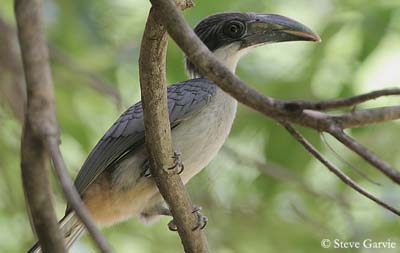
Ceylon Grey Hornbill
Ocyceros gingalensis
Bucerotiforme Order – Bucerotidae Family
BIOMETRICS:
Length: 45 cm
Weight: M: 238 g
DESCRIPTION:
Ceylon Grey Hornbill is a small species.
Adult male has dark grey upperparts with scaly effect on back and upperwing coverts. Primaries are white-tipped. The long tail shows white-tipped outer rectrices.
Underparts are greyish-white, except on vent and undertail coverts which are pale buff. Undertail feathers are creamy-white.
On the head, forehead, crown, nape and ear-coverts are brownish-grey, with fine pale streaks. Head feathers form a kind of slightly bushy crest extending to the nape. Neck, chin and throat are greyish-white.
The long down-curved bill is creamy to pale yellowish with blackish base, and black patch below the lower mandible.
Eyes are deep red, surrounded by broad bare blackish eye-ring. Legs and feet are grey.
Fr : Calao de Ceylan
All : Ceylontoko
Esp: Cálao Gris Cingalés
Ital: Bucero grigio di Sri Lanka
Nd: Ceylonese Tok
Photographs by Steve Garvie
RAINBIRDER Photo galleries
Text by Nicole Bouglouan
Sources:
HANDBOOK OF THE BIRDS OF THE WORLD Vol 6 by Josep del Hoyo-Andrew Elliott-Jordi Sargatal - Lynx Edicions, 2001 - ISBN: 848733430X
Wikipedia (Wikipedia, The Free Encyclopedia)

Adult female has similar plumage but she is smaller than male. The black bill is shorter and shows yellowish patches on the sides of the upper mandible.
Juvenile has greenish bill.

VOICE: SOUNDS BY XENO-CANTO
Ceylon Grey Hornbill gives harsh calls. Hornbills use these calls as means of communication in their forested habitat.
As most of the species, it may utter various sounds, from whistles to clucking.
HABITAT:
Ceylon Grey Hornbill is a forest-species. It frequents evergreen forests and deciduous wooded habitats and woodlands. It prefers the areas where dense creepers are growing. Large gardens and plantations may also attract the species.
It may be seen up to 1200 metres of elevation.
RANGE:
Ceylon Grey Hornbill is endemic to Sri Lanka.

BEHAVIOUR:
Ceylon Grey Hornbill often forages below the canopy among the dense vegetation. It feeds mainly on fruits such as small figs, and both wild and cultivated fruits’ species. It also consumes insects and small reptiles.
This species sometimes feeds in small groups when food resources are abundant, such as at fruiting trees.
Ceylon Grey Hornbill may perch in tree among foliage for long periods, watching around and searching for food.
They feed on more insects, reptiles, and sometimes small rodents during the nesting period, in order to provide proteins to the chicks.
Ceylon Grey Hornbill performs dispersal movements after the breeding season, from the lowland forests into hills.

FLIGHT:
Ceylon Grey Hornbill has powerful flight performed with slow, deep wing-beats and short glides.
REPRODUCTION:
Breeding season occurs from Marsh to July, with a peak in May, and sometimes until October.
Ceylon Grey Hornbill nests in natural cavity in tree, between 2 and 20 metres above the ground, sometimes in abandoned woodpecker’s hole.

Female lays 1-3 white eggs. She is shut into the hole during the nesting period. The hole is closed with mud and droppings. The narrow split allows the male to provide food to female and chicks.
She incubates the eggs during about one month. The male brings food in its throat and regurgitates at nest through the split. The larger items are delivered at bill tip.

Female moults flight feathers and rectrices while the hole is closed. She emerges from the nest four weeks before the young fledge, that occurs at about 55 days.

DIET:
Ceylon Grey Hornbill feeds primarily on fruits such as small figs. It also consumes insects, amphibians, lizards, scorpions and sometimes small rodents.
PROTECTION/THREATS/STATUS:
Ceylon Grey Hornbill has restricted range, but it is common in wet lowland forests, and occurs in several reserves.
This species is not threatened at this moment.